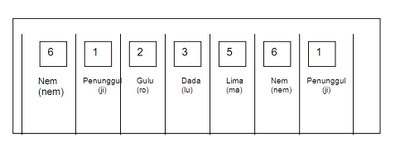 |
| A Javanese gamelan ensemble performance during a wedding in Indonesia. Image courtesy of Gunkarta/Wikipedia. |
 |
| A gamelan circa 1870-1891. Image courtesy of H. Saltzwedel/ Tropenmuseum, Netherlands. |
According to one myth, Sang Hyang Guru, a god who ruled as king of all Java in 230 CE, needed a way to summon the other gods. He invented the gong, and when he needed to send more complex messages he added two more gongs. This was the first gamelan set. The role of the gong in gamelan is to keep the beat, although there are few craftsman that can make the large gongs that were once used. Some of the oldest gongs are so revered that they are not played, and only approached through an established ritual. In fact, all the instruments are sacred and treated thus.
 |
| A set of gongs at the Indonesian embassy in Australia. Image courtesy of Wikipedia. |
The earliest known image comes from 8th century central Java. The temple of Borobudur has a bas-relief of musicians playing drums, bamboo flute, gongs, chimes, and a lute. This is perhaps the ancient form of the gamelan. Today's gamelan would typically include metallophones and xylophones.
 |
| The bas-relief at Borobudur. Image courtesy of Gunkarta/Wikipedia. |
There were once varied styles, two of which were termed "loud" and "soft", related to certain traditions. By the 17th century, these styles had mixed, albeit in different ways, allowing for regional distinctions to be recognized by listeners familiar with the genre. No two gamelans are the same, however, and each is distinguished by what instruments, voices, and tunings are chosen. For the most part, styles are categorized by geographic areas - Balinese, Javanese, and Sudanese. Outside these main areas, gamelans have spread to Malay, Suriname, and the Philippines.
Gamelan often accompanies rituals, ceremonies, dance drama and puppet performances. It is very important in rituals. The music is so pervasive that there are some gamelans that are used in Catholic ceremonies in Indonesia. Some pieces are recognized by the audience as starts and ends; when an ending piece is played it cues the audience that the concert is concluding.
 |
| A Balinese gamelan. Image courtesy www.seasite.niu.edu. |
Groups constantly revise their pieces, in keeping with the concept that music should grow and change, except for certain songs which are considered too sacred to improvise with. Most gamelan is performed in a concert setting, sometimes in an open pavilion with a roof or an open-walled community center on a platform that enhances the acoustics. Traditionally, men and women play in separate groups, except female singers sometimes perform with male groups.
Tuning the gamelan is precise and particular to each one. Instruments are often paired and tuned a bit apart to produce an interference beat, where the sound waves superpose each other, which affects the amplitude. The intention in religious ceremonies is to lead listeners to a meditative state or to feel God's presence.
 |
| All bamboo Gamelan performs in Bali, circa 1989. Image courtesy Samuel Wantman/Wikipedia. |
Originally, gamelan was like an oral tradition and was not written down, but in the 19th century in some areas a distinct notation was developed. This is only to officially record pieces, not for reading them. Today a cipher system is used that was developed circa 1900 in Surakarta, called kepatihan notation. This notation, and others based on it, record only part of the music, the rest relying on memorized patterns.
 |
| An example of a gamelan notation system. Image courtesy of this site. |
Many western composers and musicians have been influenced by gamelan. Although Claude Debussy heard a Javanese gamelan play the 1869 World's Fair in Paris, there is no evidence of influence in his work. However, his contemporary, Erik Satie, who also heard it at the same venue, incorporated it into his composition Gnossienne. Others, such as John Cage, Béla Bartók, Pierre Boulez, and Philip Glass to name but a few, also show its influence. Even modern Indonesian groups blend it with jazz and even bossanova.
 |
| A Western gamelan ensemble. Image courtesy of West Carolina University. |
Gamelan is one of the rich treasures of Indonesian culture, and as more of the world becomes exposed to it, its influences promise to be an enriching experience for music lovers everywhere.
*******************************


No comments:
Post a Comment
NOTE: COMMENTS WITH LINKS WILL NOT BE POSTED!